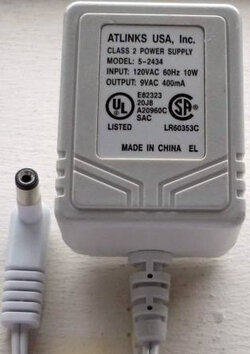- Joined
- Apr 7, 2009
I am trying to determine compatibility from set of many power adapters, a power adapter well-compatible with a telephone and answering machine multipurpose device. The OEM power adapter is not available.
The device is General Electric (GE) branded. The device, according to its label, is:
According to the manual (attached), the intended power adapter is ATLINKS USA 5-2434. I have attached a picture of the OEM adapter.
The OEM power adapter appears to be an AC to AC transformer with the following specifications
The OEM does not specify the power adapter connector polarity.
For reference I have also attached the OEM's Specification sheet and User Manual.
The AC to AC power adapters that I have at 9V AC output all have a current rating greater than the amount specified on the OEM power adapter (400 mA). For Alternating Current applications, can the rated current of a replacement power adapter much exceed what the OEM power adapter is rated for?
If the OEM does not disclose the AC polarity its device or OEM power adapter uses, is to reasonable to assume that input polarity for the telephone and answering machine multipurpose device is not significant?
The device is General Electric (GE) branded. The device, according to its label, is:
Code:
ATLINKS USA, Inc.
Model No. 29893GE1-B
FCC Registration No. 69HCHN-47150-MT-EAccording to the manual (attached), the intended power adapter is ATLINKS USA 5-2434. I have attached a picture of the OEM adapter.
The OEM power adapter appears to be an AC to AC transformer with the following specifications
Code:
INPUT: AC 120V 60hZ 10w
OUTPUT: AC 9V 400 mAThe OEM does not specify the power adapter connector polarity.
For reference I have also attached the OEM's Specification sheet and User Manual.
The AC to AC power adapters that I have at 9V AC output all have a current rating greater than the amount specified on the OEM power adapter (400 mA). For Alternating Current applications, can the rated current of a replacement power adapter much exceed what the OEM power adapter is rated for?
If the OEM does not disclose the AC polarity its device or OEM power adapter uses, is to reasonable to assume that input polarity for the telephone and answering machine multipurpose device is not significant?
